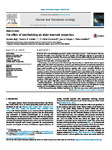The effect of interbedding on shale reservoir properties
| dc.contributor.author | Raji, M | en |
| dc.contributor.author | Gröcke, DR | en |
| dc.contributor.author | Greenwell, HC | en |
| dc.contributor.author | Gluyas, JG | en |
| dc.contributor.author | Cornford, C | en |
| dc.date.accessioned | 2023-02-16T12:20:08Z | |
| dc.date.available | 2023-02-16T12:20:08Z | |
| dc.date.issued | 2015-11-01 | en |
| dc.identifier.issn | 0264-8172 | en |
| dc.identifier.uri | http://hdl.handle.net/10026.1/20409 | |
| dc.description.abstract |
North Sea oil is overwhelmingly generated in shales of the Upper Jurassic - basal Cretaceous Kimmeridge Clay Formation. Once generated, the oil is expelled and ultimately migrates to accumulate in sandstone or carbonate reservoirs. The source rock shales, however, still contain the portion of the oil that was not expelled. As a consequence such shales and juxtaposed non-source lithofacies can form the targets for the exploration of 'unconventional oil'.In this paper, we examine part of the Kimmeridge Clay Formation as a hybrid shale resource system within which 'Hot Shale' and organic-lean sandstone and siltstone intervals are intimately interbedded. This hybrid system can contain a greater volume of oil because of the increased storage capacity due to larger matrix porosities of the sand-silt interbeds, together with a lower adsorptive affinity in the interbedded sandstone. The relationship between the estimated volume percentages of sand and mudstone and free oil determined from Rock-Eval<sup>®</sup> S1 yields is used to place limits on the drainage of oil from source mudstone to reservoir sand at the decimeter scale. These data are used to determine oil saturations in interbedded sand-mudstone sequences at peak oil maturity. Higher values of free hydrocarbon (as evidenced by the S1 value in mudstone) suggest that more oil is being retained in the mudstone, while higher S1 values in the interbedded sands suggest the oil is being drained to saturate the larger pore spaces. High silica content in the interbeds confirms the brittleness in this mudstone-sandstone lithofacies - an important factor to be considered for fracture stimulation to successfully work in a hybrid system. The key points of this hybrid unconventional system are the thickness, storage capacity and the possibility to capture a portion of the expelled, as well as retained oil. | en |
| dc.format.extent | 154 - 169 | en |
| dc.language.iso | en | en |
| dc.title | The effect of interbedding on shale reservoir properties | en |
| dc.type | Journal Article | |
| plymouth.volume | 67 | en |
| plymouth.publication-status | Published | en |
| plymouth.journal | Marine and Petroleum Geology | en |
| dc.identifier.doi | 10.1016/j.marpetgeo.2015.04.015 | en |
| plymouth.organisational-group | /Plymouth | |
| plymouth.organisational-group | /Plymouth/Faculty of Science and Engineering | |
| plymouth.organisational-group | /Plymouth/Users by role | |
| plymouth.organisational-group | /Plymouth/Users by role/Academics | |
| dc.rights.embargoperiod | Not known | en |
| rioxxterms.versionofrecord | 10.1016/j.marpetgeo.2015.04.015 | en |
| rioxxterms.licenseref.uri | http://www.rioxx.net/licenses/all-rights-reserved | en |
| rioxxterms.type | Journal Article/Review | en |


